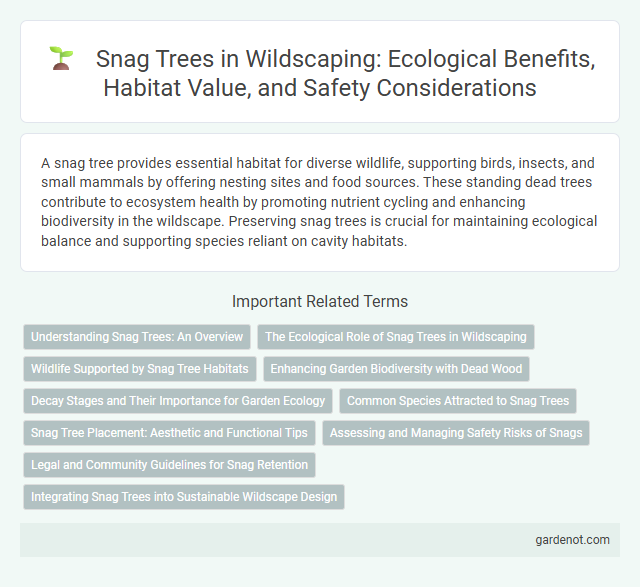A snag tree provides essential habitat for diverse wildlife, supporting birds, insects, and small mammals by offering nesting sites and food sources. These standing dead trees contribute to ecosystem health by promoting nutrient cycling and enhancing biodiversity in the wildscape. Preserving snag trees is crucial for maintaining ecological balance and supporting species reliant on cavity habitats.
Understanding Snag Trees: An Overview
Snag trees are standing dead or dying trees that provide essential habitats for various wildlife species, including birds, mammals, and insects. These trees contribute to biodiversity by supporting nesting, roosting, and foraging activities within wildscapes. Maintaining snag trees is crucial for ecosystem health, promoting natural processes such as nutrient cycling and habitat complexity.
The Ecological Role of Snag Trees in Wildscaping
Snag trees serve as critical habitats for numerous species in wildscaping environments, offering nesting sites for birds like woodpeckers and shelter for mammals such as bats. Their decaying wood supports diverse insect populations, which in turn attract predators and contribute to nutrient cycling in the ecosystem. Maintaining snag trees enhances biodiversity and promotes a balanced, healthy wildscape ecosystem.
Wildlife Supported by Snag Tree Habitats
Snag trees provide critical habitats for diverse wildlife species, including cavity-nesting birds such as woodpeckers, owls, and chickadees, as well as bats and small mammals seeking shelter. These decaying trees support insects and fungi essential for nutrient cycling, which in turn sustains food webs within forest ecosystems. The preservation of snag trees enhances biodiversity by maintaining nesting sites, foraging opportunities, and refuge from predators.
Enhancing Garden Biodiversity with Dead Wood
Snag trees, essential for enhancing garden biodiversity, provide critical habitats for birds, insects, fungi, and small mammals in wildscape environments. The presence of dead wood supports diverse ecological processes by offering nesting sites, food sources, and shelter, which promote a rich web of life. Incorporating snag trees into garden design boosts ecosystem resilience and fosters natural pest control through increased biodiversity.
Decay Stages and Their Importance for Garden Ecology
Snag trees go through distinct decay stages, each providing unique habitats critical for garden biodiversity. Early decay stages offer nesting sites for insects and birds, while advanced stages support fungi growth and nutrient cycling. Understanding these decay processes enhances garden ecology by fostering species diversity and ecosystem resilience.
Common Species Attracted to Snag Trees
Snag trees provide critical habitat for a variety of species including woodpeckers, owls, and bats, which rely on the decaying wood for nesting and foraging. Common species attracted to snag trees also include insects like beetles and ants, which contribute to the decomposition process and serve as food for birds and small mammals. These trees support biodiversity by offering shelter and resources essential for wildlife in natural forest ecosystems.
Snag Tree Placement: Aesthetic and Functional Tips
Strategically placing snag trees enhances both wildlife habitat and garden aesthetics by providing essential nesting sites for birds and insects while adding natural vertical interest. Position snags near water sources or flower beds to support pollinators and amphibians, ensuring they receive adequate sunlight to promote insect activity. Positioning these trees in visible areas elevates landscape appeal while fostering biodiversity and ecosystem balance.
Assessing and Managing Safety Risks of Snags
Snag trees provide essential habitats for wildlife but pose safety risks due to potential falling branches or collapse, especially in recreational or urban areas. Assessing snag stability involves evaluating factors such as wood decay, root integrity, and limb attachment to identify hazardous snags. Managing these risks includes strategic removal, pruning, or installing barriers to protect public safety while preserving ecological benefits.
Legal and Community Guidelines for Snag Retention
Snag tree retention is governed by strict legal frameworks aimed at protecting wildlife habitats and promoting biodiversity within community lands. Compliance with local conservation laws and community guidelines ensures sustainable forestry practices that preserve these critical ecological structures. Effective snag retention supports endangered species nesting sites and aids in maintaining ecosystem health, aligning with both environmental regulations and community stewardship goals.
Integrating Snag Trees into Sustainable Wildscape Design
Integrating snag trees into sustainable wildscape design enhances biodiversity by providing critical habitats for cavity-nesting birds, bats, and numerous invertebrates. These standing dead trees contribute to nutrient cycling and soil fertility while supporting complex food webs essential for ecosystem resilience. Strategic placement of snag trees within wildscapes fosters natural regeneration and promotes ecological balance in urban and natural landscapes.
Snag tree Infographic

 gardenot.com
gardenot.com